一、什么是NIO
1.概念
NIO是java1.4中引入的,被称为new I/O,也有说是non-blocking I/O,NIO被成为同步非阻塞的IO。
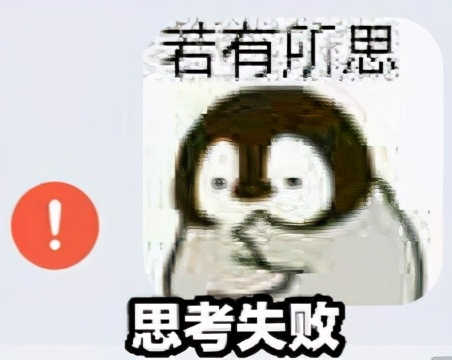
2.跟BIO流的区别
BIO是面向流的,NIO是面向块(缓冲区)的。
BIO的流都是同步阻塞的,而NIO是同步非阻塞的。
NIO会等待数据全部传输过来再让线程处理,BIO是直接让线程等待。
NIO有选择器,而BIO没有。
NIO是采用管道和缓存区的形式来处理数据的,而BIO是采用输入输出流来处理的。
NIO是可以双向的,BIO只能够单向。

二、NIO常用组件Channel和Buffer的使用
1.代码
这里以文件复制为例
public class test {
public static void main(String[] args){
try{
//存在的照片
File inFile=new File("C:\\Users\\Administrator\\Desktop\\study.PNG");
//复制后要存放照片的地址
File outFile=new File("C:\\Users\\Administrator\\Desktop\\study1.PNG");
//打开流
FileInputStream fileInputStream=new FileInputStream(inFile);
FileOutputStream fileOutputStream=new FileOutputStream(outFile);
/**
* RandomAccessFile accessFile=new RandomAccessFile(inFile,"wr");
* FileChannel inFileChannel=accessFile.getChannel();
* 和下面两行代码是一样的,都是可以拿到FileChannel
*/
//获取Channel
FileChannel inFileChannel=fileInputStream.getChannel();
FileChannel outFileChannel=fileOutputStream.getChannel();
//创建buffer
ByteBuffer buffer=ByteBuffer.allocate(1024*1024);
//读取到buffer中
while (inFileChannel.read(buffer)!=-1){
//翻转一下,就可以读取到全部数据了
buffer.flip();
outFileChannel.write(buffer);
//读取完后要clear
buffer.clear();
}
//关闭
inFileChannel.close();
outFileChannel.close();
fileInputStream.close();
fileOutputStream.close();
}catch (Exception e){}
}
}
我的桌面上的确多了一张一模一样的图片
2.解释
使用NIO的话,需要注意几个步骤:
打开流
获取通道
创建Buffer
切换到读模式 buffer.flip()
切换到写模式 buffer.clear(); 其实这里也看不出来它是怎么使用缓冲区的,上面这段代码中的while循环的作用和下面的代码是一样的
while ((i=fileInputStream.read())!=-1){
fileOutputStream.write(i);
}
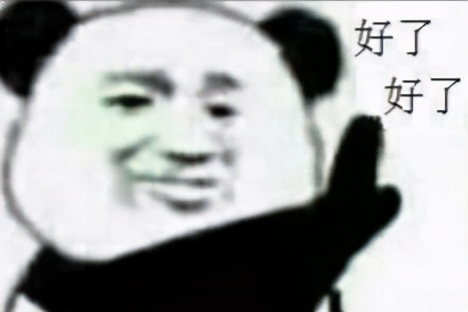
让我们赶紧开始NIO的编程
三、BIO和NIO的区别
学习了Channel和Buffer的使用,我们就可以正式进入NIO的开发了
代码
NIO
NIO服务端:只是接受客户端发送过来的数据,然后打印在控制台
/**
* NIO
* @author xuxiaobai
*/
public class NIOTest {
private final static int port = 8080;
public static void main(String[] args) throws IOException {
//启动服务端
TCPServer();
}
/**
* TCP服务端
* 接受TCP
*
* @throws IOException
*/
public static void TCPServer() throws IOException {
//创建服务端多路复用选择器
Selector selector = Selector.open();
//创建服务端SocketChannel
ServerSocketChannel serverSocketChannel = ServerSocketChannel.open();
//定义地址
InetSocketAddress inetSocketAddress = new InetSocketAddress(InetAddress.getLocalHost(), port);
//绑定地址
serverSocketChannel.bind(inetSocketAddress);
System.out.println("绑定成功:" + inetSocketAddress);
//设置为非阻塞
serverSocketChannel.configureBlocking(false);
//注册服务端选择端,只接受accept事件
serverSocketChannel.register(selector, SelectionKey.OP_ACCEPT);
while (true) {
//加上延时,什么原理我忘记了,只知道是为了防止死锁
selector.select(500);
//遍历服务端选择器的事件
Iterator<SelectionKey> iterator = selector.selectedKeys().iterator();
while (iterator.hasNext()) {
SelectionKey next = iterator.next();
if (!next.isValid()) {
//该key无效直接跳过
continue;
}
//注意
if (next.isAcceptable()) {
//1\. accept事件
//接收到accept事件,拿到channel,这个是服务端SocketChannel
ServerSocketChannel channel = (ServerSocketChannel) next.channel();
//accept得到连接客户端的channel
SocketChannel accept = channel.accept();
accept.configureBlocking(false);
//注册write事件
accept.register(selector, SelectionKey.OP_READ);
iterator.remove();
} else if (next.isReadable()) {
//2\. read事件
//开启一个新的线程
Thread thread = new Thread(() -> {
SocketChannel channel = (SocketChannel) next.channel();
ByteBuffer byteBuffer = ByteBuffer.allocate(1024);
byteBuffer.clear();
try {
channel.read(byteBuffer);
//开始处理数据
byteBuffer.flip();
byte[] bytes = new byte[byteBuffer.remaining()];
byteBuffer.get(bytes);
String x = new String(bytes);
if(x.equals("")){
//老是会莫名其妙地打印一些空行,打个补丁
return;
}
System.out.println(x);
if ("exit".equals(x)) {
//关闭通道
try {
channel.close();
} catch (IOException e) {
e.printStackTrace();
}
next.cancel();
}
} catch (IOException e) {
//出现异常的处理
e.printStackTrace();
try {
channel.close();
} catch (IOException ioe) {
ioe.printStackTrace();
}
next.cancel();
}
});
iterator.remove();
thread.start();
}
}
}
}
}
BIO
BIO服务端:接受客户端的数据,然后打印在控制台
BIO客户端:向服务端发送数据。NIO的测试中也使用这个客户端进行测试
/**
* BIO
* @author xuxiaobai
*/
public class BIOTest {
private final static int port = 8080;
public static void main(String[] args) throws IOException {
TCPClient();
// TCPServer();
}
/**
* TCP客户端
* 发送TCP
* @throws IOException
*/
private static void TCPClient() throws IOException {
SocketChannel socketChannel = SocketChannel.open();
//定义地址
InetSocketAddress inetSocketAddress = new InetSocketAddress(InetAddress.getLocalHost(), port);
//连接
socketChannel.connect(inetSocketAddress);
System.out.println("连接成功:"+inetSocketAddress);
Scanner scanner = new Scanner(System.in);
while (true) {
String next = scanner.next();
//直接包装一个buffer
ByteBuffer wrap = ByteBuffer.wrap(next.getBytes());
//写入
socketChannel.write(wrap);
if ("exit".equals(next)) {
//等于exit时关闭channel
socketChannel.close();
break;
}
}
}
/**
* TCP服务端
* 接受TCP
* @throws IOException
*/
private static void TCPServer() throws IOException {
ServerSocketChannel serverSocketChannel = ServerSocketChannel.open();
//定义地址
InetSocketAddress inetSocketAddress = new InetSocketAddress(InetAddress.getLocalHost(), port);
//绑定
serverSocketChannel.bind(inetSocketAddress);
System.out.println("绑定成功:"+inetSocketAddress);
while (true) {
//接受连接
SocketChannel accept = serverSocketChannel.accept();
new Thread(new Runnable() {
@Override
public void run() {
//定义一个缓冲区,读出来的数据超出缓冲区的大小时会被丢弃
ByteBuffer byteBuffer = ByteBuffer.allocate(1024);
while (true) {
try {
//每次使用前都要清空,但这里没有真的区clear数据,只是移动了buffer里面的下标
byteBuffer.clear();
//读取数据到缓冲区
accept.read(byteBuffer);
//每次读取数据前都要flip一下,这里都移动下标
byteBuffer.flip();
byte[] bytes = new byte[byteBuffer.remaining()];
//获取数据
byteBuffer.get(bytes);
String x = new String(bytes);
System.out.println(x);
if (x.equals("exit")) {
//当读出来的数据等于exit时退出
accept.close();
break;
}
} catch (Exception e) {
e.printStackTrace();
}
}
}
}).start();
//启动该线程
}
}
}

搞完了代码,让我们来看看代码的演示效果————从客户端发送数据到服务端,下面展示一下效果:
先后启动BIO的TCPServer和TCPClient方法;
TCPClient:

TCPServer:

步骤
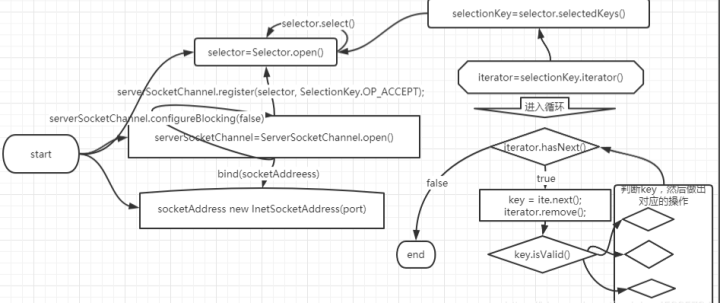
画了个图来表示,这是关于selector的配置流程,在循环中根据不同key值所进行的操作,跟上面文件复制的例子差不多了,只不过这里的Channel是通过 key.channel()获得的。
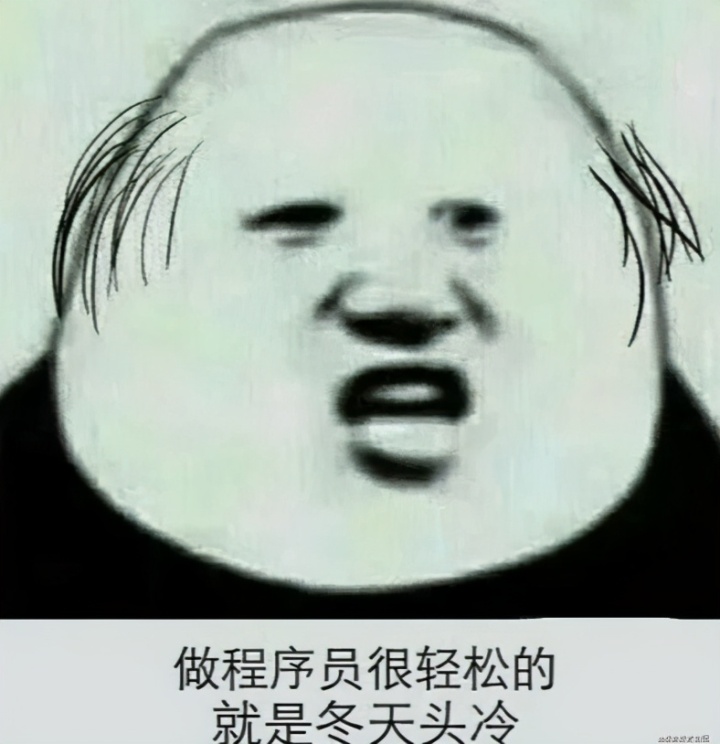
差别
我们来看看一下BIO和NIO的差别。
BIO
我们用IDEA的debug启动BIO的服务端,然后在启动多个客户端。

我这里启动了三个客户端,可以看到有三个线程已经创建好了,然而我这时还没有发送数据到服务端。
NIO
我们用IDEA的debug启动NIO的服务端,然后在启动多个BIO客户端。
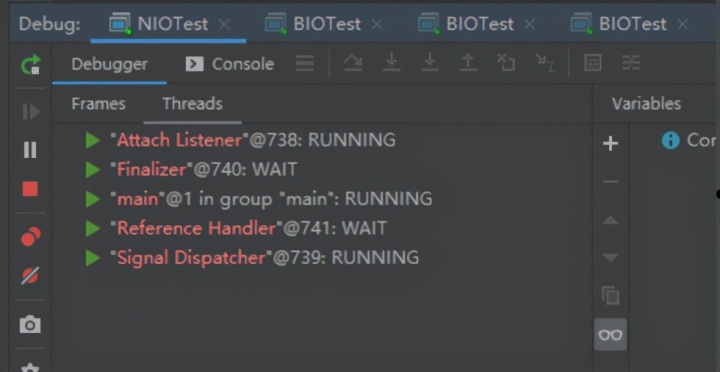
这里启动了多个客户端,服务器上没有多余的几个线程。
修改BIO的TCPClient方法
private static void TCPClient() throws IOException {
SocketChannel socketChannel = SocketChannel.open();
//定义地址
InetSocketAddress inetSocketAddress = new InetSocketAddress(InetAddress.getLocalHost(), port);
//连接
socketChannel.connect(inetSocketAddress);
System.out.println("连接成功:" + inetSocketAddress);
Scanner scanner = new Scanner(System.in);
while (true) {
String next = scanner.next();
//直接包装一个buffer
// ByteBuffer wrap = ByteBuffer.wrap(next.getBytes());
//写入
while (true) {
try {
//休眠
//注意,休眠时间建议调高一点
Thread.sleep(1500);
} catch (InterruptedException e) {
e.printStackTrace();
}
socketChannel.write(ByteBuffer.wrap(next.getBytes()));
}
// if ("exit".equals(next)) {
// //等于exit时关闭channel
// socketChannel.close();
// break;
// }
}
}
休眠时间记得调高点!!!宕机警告!

这样客户端就会在读取到第一次时,一直发送这个数据,可以看到一些线程,也是只有在收到数据之后才会创建这个线程去打印这个数据。如果休眠时间调高一点的话,就会看到有时候这里会一闪一闪的,调低后就会出现一闪而过的很多线程,如下图。
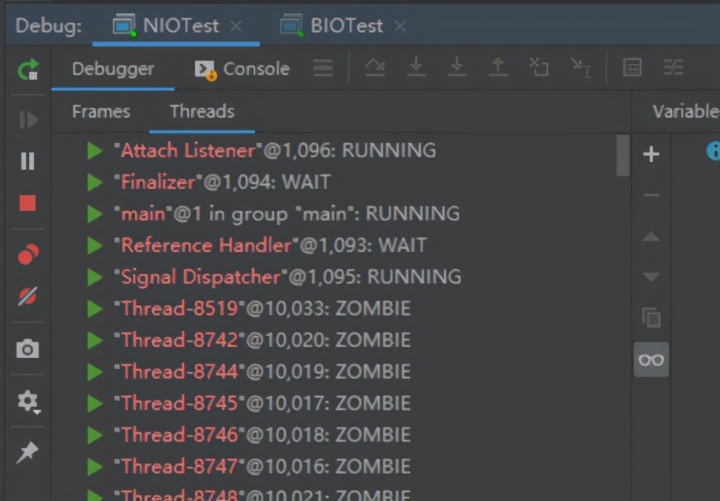
四、总结
BIO的话,每次网络请求过来之后,服务器都是会为这个请求创建一个线程,这个线程会一直等待这个请求后续的数据,等处理完成后才会销毁这个线程;而NIO,当每次网络请求过来时,服务器不会马上创建一个线程去处理这个请求,而是会交给一个Selector线程,只有这个请求后续的数据全部传输过来后,Selector才会去通知其他其他线程或者创建一个线程来处理这个请求。
这就是NIO和BIO最大的差别,只有数据传输到服务器时才会让线程去处理,减少了线程的空等待,大部分情况下可以采用线程池的方式来处理数据,可以提高线程的利用率。









